EY refers to the global organization, and may refer to one or more, of the member firms of Ernst & Young Global Limited, each of which is a separate legal entity. Ernst & Young Global Limited, a UK company limited by guarantee, does not provide services to clients.
Smart Health Solutions
In Health Sciences and Wellness
What EY can do for you
In health care, there are many ecosystems, quickly evolving technologies and massive amounts of data, all untidy and uncoordinated. EY teams have a strategic vision on how to use those tools, ecosystems, structures, and data to drive better experiences for all stakeholders—including both patients and clinicians.
To bring the smart health vision to life, EY teams convene and connect the entire health care ecosystem. We explore where opportunities for collaboration exist and use our experience in technology, strategic planning, organizational design, and process transformation to drive better outcomes for all.
EY Smart Health Experience
Accustomed to self-directed experiences in other areas of their digital lives, consumers and clinicians expect something more from health care. Smart health experiences repositions how care is organized and delivered, optimizing the wellness journey — a key differentiator in long term value for the health industry.
Smart health starts by getting the consumer experience right through human-centered design, which is, quite simply, designing for people. By focusing upon what matters most to the health care consumer and to the workforce, EY teams work with organizations to create a more personalized technology-enabled health and well-being experience and a modernized work environment.
In a smart health system, automation and digitization are re-shaping how the entire system works together for a better care experience.
We use an experience-led approach and work with hospitals and health systems to introduce digitally-enabled front-, middle- and back-office operations that support the end-to-end consumer and clinician experience.
The EY Smart Health Experience suite of solutions includes:
- Persona definition
- Patient, provider, employee, and broker journey mapping and service design
- Ecosystem definition
- Customer behavioral insights
- Customer-led strategy, capability and roadmap creation
- Business case definition
- Digital employee and caregiver onboarding
- Definition of wireframes and prototypes
- Product development, launch and scale
- Operating model definition
- Experience-led digital enterprise transformation
EY Smart Health Analytics
EY teams are working with health organizations to help them use smarter analytics that provide a more complete view of the patients and communities they serve. Combining and analyzing data from the wealth of available sources – from wearable devices to social and economic indicators – makes health care more personal, more effective, more efficient and more equitable. That means better insights for you, driving better health care for everyone.
How EY Smart Health Analytics supports you
1. Curate live data sets that you control
Combine data from a full range of internal and external sources to create live data sets that provide a comprehensive view of each patient. Retain full control of your data and how it is used.
2. Analyze your data in ways that matter to you
Use data sets and algorithms that are customized to meet your specific needs, so you create relevant insights based on a fuller understanding of the patients and populations you serve. Identify how a patient’s wider context could affect their health today and, in the future, and how you could provide better care and support with the resources at your disposal.
3. Drive action that makes a real difference
Make it easier for people across your health ecosystem – including clinicians, management and partners – to understand your insights so they can take action that makes a difference. Use powerful visualizations to filter out what doesn’t matter and to focus on what does. Share relevant insights with patients in ways that improve their care and build trust.
EY teams are working with health organizations to help them use smarter analytics and algorithms that give them a more complete view of the patients and communities they serve. Combining and analyzing data from the widest possible range of sources – from wearable devices to social and economic indicators – makes health care more personal, more effective, more efficient and more equitable. Better insights for you can mean better health care for everyone.
EY Smart Hospital and Health Care Transformation
Health care transformation connects the dots between operations, people, the environment and technology to deliver more connected and efficient care. The EY Health Care Transformation team supports health care providers and payers in their journey from traditional to smart by leveraging virtual care platforms, interoperable patient records and digital enablers (e.g., the internet of things (IoT), 5G, artificial intelligence (AI), remote monitoring) to optimize care and shift the focus from volume to value in a controlled and agile way.
We bring deep knowledge and insights that help you balance clinical outcomes, cost and operational optimization, patient experience and talent management to transform and optimize your organization.
EY Health care Transformation teams work across the health ecosystem: from establishing clinical operations initiatives to implementing the architecture and operations around digital assets and analytics. Our goal is to help our clients realize efficiencies and drive a differentiated experience by sharing leading practices that optimize performance and enable better outcomes.
EY Virtual Care
EY teams are working with health organizations to help them design and implement virtual care models that transform what they do, how they do it, and the results they achieve. Virtual care can mean better health and a better care experience for patients and their families, greater job satisfaction for health workers at every level, and better outcomes for health systems overall. Virtual care works best when it works for everyone.
How EY Virtual Care supports you
1. See where virtual care can transform how you work
Create and model different scenarios that reveal where your resources are currently focused. Identify how virtual care could help you make better use of scarce facilities, finances and people. Access the business, health management, and clinical knowledge needed to understand the complexity of your organization and to find ways of making it work better.
2. Identify clear benefits and actionable priorities
Define where specific virtual care investments could make a measurable difference to health outcomes for the patients and populations you serve. See how better outcomes and better performance translates into financial value for your organization. Create a roadmap and actionable plans to capture this value and to make it happen at scale.
About EY Virtual Care Investment Analysis Framework
The EY Virtual Care Investment Analysis Framework generates multiple dynamic scenarios that answer “what if” questions for better decision-making. Apply rigorous financial analyses based on measures derived from market research to quantify the financial impact associated with integrating virtual care. Work with EY teams and deploy the EY Virtual Care Investment Analysis Framework to determine how an integrated virtual care strategy could help you improve both health outcomes and your bottom line.
3. Move forward at speed
Build cultural and financial support for virtual care by showing that the interventions you are putting in place achieve the expected return on investment and make measurable improvements in patient outcomes. Implement new virtual care models and technologies and integrate them with your existing digital and data infrastructure to manage growing demand. Engage your team to drive adoption and build excitement around new ways of caring for patients.
EY teams are working with health organizations to help them design and implement virtual care models that transform what they do, how they do it, and the results they achieve. That means better health and a better care experience for patients and their families, greater job satisfaction for health workers at every level, and better outcomes for health systems overall. Virtual care works best when it works for everyone.
EY Connected Health Cloud
EY teams are working with health organizations to create open, connected technology ecosystems that help enable better patient experiences and better health outcomes. And when it’s quicker and easier to share deeper data, everyone serving the patient benefits. Connected health care means better health care.
How EY Connected Health Cloud supports you
1. Makes data available in a format that works
Create and structure data in a computer readable format that captures the rich complexity of information needed to transform patient experiences and outcomes. Modern health care interoperability standards like Health Level Seven (HL7) fast healthcare interoperability resources (FHIR) only capture a fraction of the data needed for the ecosystems of the future.
By contrast, EY Connected Health Cloud is built with the combination of openEHR, a semantically rich format that captures far more patient information, to store and publish data and HL7 FHIR for exchanging data for specific use cases. The openEHR data definitions are publicly available in multiple languages, and link with broadly accepted health terminology standards like SNOMED clinical terms (CT) and logical observation identifiers names and codes (LOINC) and is independent of any technology vendor. The better the data you collect, the better the health care you can provide.
2. Makes data available where and when it’s needed
Create open data platforms, so everyone can provide and access data from a range of devices and systems. When data is connected and flowing easily, you can support people to do their best work – from frontline clinical staff caring for patients today, to health managers and leaders planning for the future. These open data platforms should adhere to the findable, accessible, interoperable, and reusable (FAIR) principles and allow data to be captured once and shared in a secure, private way many times.
3. Builds a future-ready data infrastructure
Modern open data interfaces, including representational state transfer application programming interfaces (REST APIs) make it easier for you to add new technologies and partners to your ecosystem, so you can innovate faster. Semantically rich data formats that capture a more complete picture of the patient give you the platform needed to deliver personalized care over the patient’s lifetime.
EY teams are working with health organizations to create open, connected technology ecosystems that help enable better patient experiences and better health outcomes. When it’s quicker and easier to share deeper data, everyone serving the patient benefits. Connected health care means better health care.
Our latest thinking
As technology becomes smarter, is your hospital keeping up?
In a smart hospital, people, their environment and systems are connected in real time and the data generated is used in intelligent ways.
How COVID-19 has triggered a sprint toward smarter health care
Responding to COVID-19 shattered preconceptions of what it takes to create a digital-first health experience.
How will you design information architecture to unlock the power of data?
As emerging technologies transform health and care, we explore how to create the right data environment for a connected health ecosystem.
What connections will move health from reimagining to reality?
In the 2019 edition of New Horizons, we explore how the health sector can begin executing on a new vision of a connected health ecosystem.








